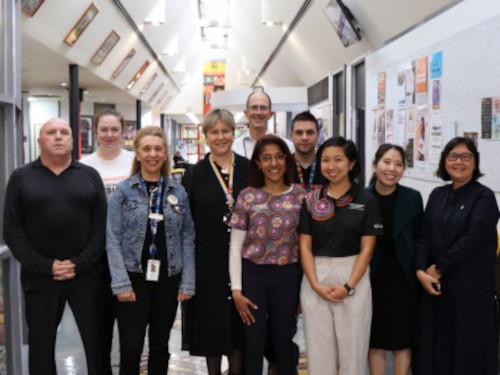Industry News
ACO and VAHS Celebrate 25 Years of Visionary Care for Indigenous Communities
 The Australian College of Optometry (ACO) and the Victorian Aboriginal Health Service (VAHS) marked a significant milestone by celebrating 25 years of dedicated optometry services for Aboriginal and Torres Strait Islander peoples on this year's World Sight Day.
The Australian College of Optometry (ACO) and the Victorian Aboriginal Health Service (VAHS) marked a significant milestone by celebrating 25 years of dedicated optometry services for Aboriginal and Torres Strait Islander peoples on this year's World Sight Day.
The commemorative event brought together ACO and VAHS staff, colleagues, and supporters from various organizations, including the Eye and Ear Hospital, Fred Hollows Foundation, the Indigenous Eye Health Unit (University of Melbourne), and Optometry Australia. A special guest at the celebration was May Ho, Optometry and Primary Health Advisor at Fred Hollows and the first ACO optometrist assigned to the VAHS clinic in 1998.
The integrated optometry clinic at VAHS' Fitzroy site has played a pivotal role in removing barriers to eye care faced by Aboriginal and Torres Strait Islander communities, addressing the systemic disparities that have long persisted in mainstream services.
Advocating for Community-Controlled Eye Care
The VAHS ACO clinic was established in 1998 at a time when blindness was reported to be ten times more prevalent among Aboriginal and Torres Strait Islander people than in the rest of the Australian population. Much of this vision loss and blindness was attributed to diabetic retinopathy, which disproportionately affects these communities and can be prevented with regular screening and timely access to treatment. Following the guidelines outlined in the National Aboriginal Health Strategy, the ACO and VAHS embarked on a mission to enhance community eye health outcomes through community control and active participation in service delivery.
Today, the VAHS ACO optometry clinic provides culturally safe care, with sessions running twice a week. Nilmini John, ACO Manager of Aboriginal Services, leads a team of four optometrists dedicated to serving the embedded clinic. In her role, Nilmini collaborates closely with the VAHS team to ensure the ongoing fulfillment of community eye health needs.
"As health practitioners, we're accustomed to advising patients on what they should do, but when working with First Nations clients, it's crucial to ensure that patients feel empowered to make decisions for themselves. We must provide our patients with as much information as possible, avoiding technical jargon, so they can make informed decisions about their health. This is self-determination at its core," emphasized Nilmini.
Reflecting on 25 Years of Progress
What began as a single optometry clinic a quarter of a century ago has since evolved significantly to support the health needs of the local Aboriginal and Torres Strait Islander community. In 2018, the Royal Victorian Eye and Ear Hospital (Eye and Ear) introduced ophthalmology services, conducting regular clinics every two weeks. This expansion ensures that community members have access to a comprehensive range of eye health services, from primary optometry to laser and injection treatment, as well as post-operative check-ups.
Furthermore, in 2022, VAHS appointed Kelli McGuinness as the Aboriginal Eye Health Worker (AEHW), a role established in consultation with ACO optometrists and Dr. Rosie Dawkins from the Eye and Ear. The role became possible with funding from the Fred Hollows Foundation.
Gavin Brown, VAHS Chief Operating Officer, expresses his passion for the growth of eye care services available to Aboriginal and Torres Strait Islander peoples. He acknowledges VAHS's role as a recognized leader in the eye health field and applauds the incredible work done by Aboriginal Community Controlled Health Organizations (ACCHOs) across Australia.
Addressing Future Challenges in Indigenous Eye Health
Despite the successes achieved through the dedicated eye care services at VAHS Fitzroy, challenges persist in achieving equitable eye health for Aboriginal and Torres Strait Islander communities. In 2020, an annual update on the implementation of the Roadmap to Close the Gap for Vision reported that the rate of blindness among Aboriginal and Torres Strait Islander adults had decreased nationally but still remained three times higher than that of other populations.
Collaboration between healthcare providers and ACCHOs has been instrumental in making a meaningful impact on Aboriginal and Torres Strait Islander health outcomes. The ACO acknowledges the importance of working within community-controlled spaces, such as VAHS, to deliver effective care.
Dr. Josephine Li, ACO General Manager of Rural VES and Outreach Programs, emphasized the vital role that community-controlled health services and Aboriginal and Torres Strait Islander voices play in achieving the best possible health outcomes. She underlined the necessity of this invaluable input across all health services and policies throughout Australia to enhance the well-being of Aboriginal and Torres Strait Islander communities.


